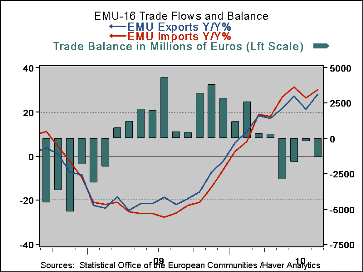 Global| Oct 15 2010
Global| Oct 15 2010Euro Exports Regain Their Step But They Are Still Overtaken By Imports
Summary
In Europe the trade picture deteriorated even as exports recovered strongly from their slump in July. Goods exports rose by 1% on the month, shaking off a 0.2% decline in July. Imports of goods, a series that had declined by a sharp [...]
 In Europe the trade picture deteriorated even as exports recovered strongly from their slump in July.
Goods exports rose by 1% on the month, shaking off a 0.2% decline in July.
In Europe the trade picture deteriorated even as exports recovered strongly from their slump in July.
Goods exports rose by 1% on the month, shaking off a 0.2% decline in July.
Imports of goods, a series that had declined by a sharp 1.3% in July (m/m), surged ahead gaining 1.8% (m/m) in August. As imports were stronger than exports, the trade deficit for the Zone deteriorated rising to a deficit of €1.4bln from a deficit of €0.2bln (revised) in July.
Despite the monthly rebound in both exports and in imports exports have lost momentum Yr/Yr Imports are now consistently starting to outdistance exports, at least in their Yr/Yr growth.
Raw materials imports are up especially sharply Yr/Yr in the midst of a global push on commodity prices spurred by an ongoing bump-up in the price of oil. Still, the euro has been gaining Vs the dollar; that will take some sting out of the rise in dollar prices of global commodities in the months ahead; there is already evidence that nominal flows are being reduced as the strong euro has worked its magic in recent months.
Still export and import trends may be in flux. Over three-months exports are stronger but over six months import growth is superior.
Over the last six months the 14-month string of trade surpluses has been diminished and turned to outright deficits over the last four. That tells you something about the balance of export and import growth. Still, there is scant evidence that domestic demand has picked up in the Zone. For that determination we are still waiting. Until then, exports and imports may continue to play tag with their short term growth rates.
| Euro-Area Trade Trends For Goods | ||||||
|---|---|---|---|---|---|---|
| M/M% | % SAAR | |||||
| Aug-10 | Jul-10 | 3M | 6M | 12M | 12M Ago | |
| Balance* | € (1,368) | € (248) | € 2,778 | € (935) | € (819) | € (2,564) |
| EXPORTS | ||||||
| All Exp | 1.0% | -0.2% | 27.8% | 29.2% | 28.0% | -21.8% |
| Food and Drinks | -0.9% | -1.5% | 10.6% | 14.2% | 15.3% | -11.2% |
| Raw materials | -4.8% | 1.6% | 5.4% | 13.3% | 22.4% | -17.5% |
| Other | 1.3% | -0.1% | 29.8% | 30.8% | 29.2% | -22.7% |
| MFG | 0.0% | -1.7% | 21.1% | 32.5% | 28.1% | -22.6% |
| IMPORTS | ||||||
| All IMP | 1.8% | -1.3% | 21.3% | 37.9% | 29.9% | -25.7% |
| Food and Drinks | 0.8% | -2.3% | 11.2% | 23.7% | 13.5% | -10.1% |
| Raw materials | -1.3% | -0.7% | 13.1% | 76.6% | 57.7% | -37.6% |
| Other | 2.1% | -1.2% | 22.5% | 37.2% | 29.8% | -26.0% |
| MFG | 0.4% | -1.1% | 21.3% | 37.7% | 29.0% | -21.2% |
| *Eur mlns; mo or period average (SA, WDA) | ||||||
Robert Brusca
AuthorMore in Author Profile »Robert A. Brusca is Chief Economist of Fact and Opinion Economics, a consulting firm he founded in Manhattan. He has been an economist on Wall Street for over 25 years. He has visited central banking and large institutional clients in over 30 countries in his career as an economist. Mr. Brusca was a Divisional Research Chief at the Federal Reserve Bank of NY (Chief of the International Financial markets Division), a Fed Watcher at Irving Trust and Chief Economist at Nikko Securities International. He is widely quoted and appears in various media. Mr. Brusca holds an MA and Ph.D. in economics from Michigan State University and a BA in Economics from the University of Michigan. His research pursues his strong interests in non aligned policy economics as well as international economics. FAO Economics’ research targets investors to assist them in making better investment decisions in stocks, bonds and in a variety of international assets. The company does not manage money and has no conflicts in giving economic advice.






